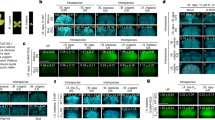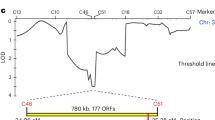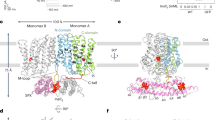Abstract
Self-incompatibility (SI) is a widespread mechanism in flowering plants which prevents self-fertilization and inbreeding. In Brassica, recognition of the highly polymorphic S-locus cysteine-rich protein (SCR; or S-locus protein 11) by the similarly polymorphic S-locus receptor kinase (SRK) dictates the SI specificity. Here, we report the crystal structure of the extracellular domain of SRK9 (eSRK9) in complex with SCR9 from Brassica rapa. SCR9 binding induces eSRK9 homodimerization, forming a 2:2 eSRK:SCR heterotetramer with a shape like the letter “A”. Specific recognition of SCR9 is mediated through three hyper-variable (hv) regions of eSRK9. Each SCR9 simultaneously interacts with hvI and one-half of hvII from one eSRK9 monomer and the other half of hvII from the second eSRK9 monomer, playing a major role in mediating SRK9 homodimerization without involving interaction between the two SCR9 molecules. Single mutations of residues critical for the eSRK9-SCR9 interaction disrupt their binding in vitro. Our study rationalizes a body of data on specific recognition of SCR by SRK and provides a structural template for understanding the co-evolution between SRK and SCR.
Similar content being viewed by others
Log in or create a free account to read this content
Gain free access to this article, as well as selected content from this journal and more on nature.com
or
References
Takayama S, Isogai A . Self-incompatibility in plants. Annu Rev Plant Biol 2005; 56:467–489.
Kitashiba H, Nasrallah JB . Self-incompatibility in Brassicaceae crops: lessons for interspecific incompatibility. Breed Sci 2014; 64:23–37.
Stein JC, Howlett B, Boyes DC, Nasrallah ME, Nasrallah JB . Molecular cloning of a putative receptor protein kinase gene encoded at the self-incompatibility locus of Brassica oleracea. Proc Natl Acad Sci USA 1991; 88:8816–8820.
Schopfer CR, Nasrallah ME, Nasrallah JB . The male determinant of self-incompatibility in Brassica. Science 1999; 286:1697–1700.
Shiba H, Takayama S, Iwano M, et al. A pollen coat protein, SP11/SCR, determines the pollen S-specificity in the self-incompatibility of Brassica species. Plant Physiol 2001; 125:2095–2103.
Suzuki G, Kai N, Hirose T, et al. Genomic organization of the S locus: identification and characterization of genes in SLG/SRK region of S(9) haplotype of Brassica campestris (syn. rapa). Genetics 1999; 153:391–400.
Nasrallah JB, Kao TH, Chen CH, Goldberg ML, Nasrallah ME . Amino-acid sequence of glycoproteins encoded by three alleles of the S locus of Brassica oleracea. Nature 1987; 326:617–619.
Takasaki T, Hatakeyama K, Suzuki G, Watanabe M, Isogai A, Hinata K . The S receptor kinase determines self-incompatibility in Brassica stigma. Nature 2000; 403:913–916.
Kachroo A, Schopfer CR, Nasrallah ME, Nasrallah JB . Allele-specific receptor-ligand interactions in Brassica self-incompatibility. Science 2001; 293:1824–1826.
Takayama S, Shimosato H, Shiba H, et al. Direct ligand-receptor complex interaction controls Brassica self-incompatibility. Nature 2001; 413:534–538.
Takayama S, Shiba H, Iwano M, et al. The pollen determinant of self-incompatibility in Brassica campestris. Proc Natl Acad Sci USA 2000; 97:1920–1925.
Ivanov R, Fobis-Loisy I, Gaude T . When no means no: guide to Brassicaceae self-incompatibility. Trends Plant Sci 2010; 15:387–394.
Shimosato H, Yokota N, Shiba H, et al. Characterization of the SP11/SCR high-affinity binding site involved in self/nonself recognition in Brassica self-incompatibility. Plant Cell 2007; 19:107–117.
Iwano M, Takayama S . Self/non-self discrimination in angiosperm self-incompatibility. Curr Opin Plant Biol 2012; 15:78–83.
Shiu SH, Karlowski WM, Pan R, Tzeng YH, Mayer KF, Li WH . Comparative analysis of the receptor-like kinase family in Arabidopsis and rice. Plant Cell 2004; 16:1220–1234.
Shiu SH, Bleecker AB . Plant receptor-like kinase gene family: diversity, function, and signaling. Sci STKE 2001; 2001:re22.
Naithani S, Chookajorn T, Ripoll DR, Nasrallah JB . Structural modules for receptor dimerization in the S-locus receptor kinase extracellular domain. Proc Natl Acad Sci USA 2007; 104:12211–12216.
Kusaba M, Nishio T, Satta Y, Hinata K, Ockendon D . Striking sequence similarity in inter- and intra-specific comparisons of class I SLG alleles from Brassica oleracea and Brassica campestris: implications for the evolution and recognition mechanism. Proc Natl Acad Sci USA 1997; 94:7673–7678.
Sato K, Nishio T, Kimura R, et al. Coevolution of the S-locus genes SRK, SLG and SP11/SCR in Brassica oleracea and B. rapa. Genetics 2002; 162:931–940.
Kemp BP, Doughty J . S cysteine-rich (SCR) binding domain analysis of the Brassica self-incompatibility S-locus receptor kinase. New Phytol 2007; 175:619–629.
Boggs NA, Dwyer KG, Nasrallah ME, Nasrallah JB . In vivo detection of residues required for ligand-selective activation of the S-locus receptor in Arabidopsis. Curr Biol 2009; 19:786–791.
Mishima M, Takayama S, Sasaki K, et al. Structure of the male determinant factor for Brassica self-incompatibility. J Biol Chem 2003; 278:36389–36395.
Chookajorn T, Kachroo A, Ripoll DR, Clark AG, Nasrallah JB . Specificity determinants and diversification of the Brassica self-incompatibility pollen ligand. Proc Natl Acad Sci USA 2004; 101:911–917.
Sauerborn MK, Wright LM, Reynolds CD, Grossmann JG, Rizkallah PJ . Insights into carbohydrate recognition by Narcissus pseudonarcissus lectin: the crystal structure at 2 A resolution in complex with alpha1-3 mannobiose. J Mol Biol 1999; 290:185–199.
Wouters MA, Rigoutsos I, Chu CK, Feng LL, Sparrow DB, Dunwoodie SL . Evolution of distinct EGF domains with specific functions. Protein Sci 2005; 14:1091–1103.
Cooke RM, Wilkinson AJ, Baron M, et al. The solution structure of human epidermal growth factor. Nature 1987; 327:339–341.
Birchmeier C, Birchmeier W, Gherardi E, Vande Woude GF . Met, metastasis, motility and more. Nat Rev Mol Cell Biol 2003; 4:915–925.
Almeida MS, Cabral KM, Kurtenbach E, Almeida FC, Valente AP . Solution structure of Pisum sativum defensin 1 by high resolution NMR: plant defensins, identical backbone with different mechanisms of action. J Mol Biol 2002; 315:749–757.
He XL, Li HM, Zeng ZH, Liu XQ, Wang M, Wang DC . Crystal structures of two alpha-like scorpion toxins: non-proline cis peptide bonds and implications for new binding site selectivity on the sodium channel. J Mol Biol 1999; 292:125–135.
Giranton JL, Dumas C, Cock JM, Gaude T . The integral membrane S-locus receptor kinase of Brassica has serine/threonine kinase activity in a membranous environment and spontaneously forms oligomers in planta. Proc Natl Acad Sci USA 2000; 97:3759–3764.
Lemmon MA, Schlessinger J . Cell signaling by receptor tyrosine kinases. Cell 2010; 141:1117–1134.
Han Z, Sun Y, Chai J . Structural insight into the activation of plant receptor kinases. Curr Opin Plant Biol 2014; 20:55–63.
Liu T, Liu Z, Song C, et al. Chitin-induced dimerization activates a plant immune receptor. Science 2012; 336:1160–1164.
Sato Y, Okamoto S, Nishio T . Diversification and alteration of recognition specificity of the pollen ligand SP11/SCR in self-incompatibility of Brassica and Raphanus. Plant Cell 2004; 16:3230–3241.
Otwinowski Z, Minor W . Processing of X-ray diffraction data collected in oscillation mode. Methods Enzymol 1997; 276:307–326.
Sheldrick GM . A short history of SHELX. Acta Crystallogr A 2008; 64:112–122.
Emsley P, Cowtan K . Coot: Model-building tools for molecular graphics. Acta Crystallogr D Biol Crystallogr 2004; 60:2126–2132.
Adams PD, Grosse-Kunstleve RW, Hung LW, et al. PHENIX: building new software for automated crystallographic structure determination. Acta Crystallogr D Biol Crystallogr 2002; 58:1948–1954.
Xiang Z, Soto C, Honig B . Evaluating conformational free energies: the colony energy and its application to the problem of loop prediction. Proc Natl Acad Sci USA 2002; 99:7432–7437.
Yang J, Yan R, Roy A, Xu D, Poisson J, Zhang Y . The I-TASSER Suite: protein structure and function prediction. Nat Methods 2015; 12:7–8.
Gong X, Wang P, Yang F, et al. Protein-protein docking with binding site patch prediction and network-based terms enhanced combinatorial scoring. Proteins 2010; 78:3150–3155.
Pronk S, Pail S, Schulz R, et al. GROMACS 4.5: a high-throughput and highly parallel open source molecular simulation toolkit. Bioinformatics 2013; 29:845–854.
Acknowledgements
We thank J He at Shanghai Synchrotron Radiation Facility (SSRF) for assistance with x-ray data collection. This research was funded by grants from Projects of International Cooperation and Exchanges NSFC (31420103906), National Natural Science Foundation of China (31130063 and 31421001), and Chinese Ministry of Science and Technology (2015CB910200) to JC.
Author information
Authors and Affiliations
Corresponding author
Additional information
( Supplementary information is linked to the online version of the paper on the Cell Research website.)
Supplementary information
Supplementary information, Table S1
Data collection and Refinement Statistics (PDF 259 kb)
Supplementary information, Figure S1
Structure of the two N-terminal lectin domains of SRK9. (PDF 109 kb)
Supplementary information, Figure S2
Sequence alignment of the N-terminal lectin domains of eSRK9 with S-domain proteins from Arabidopsis thaliana. (PDF 773 kb)
Supplementary information, Figure S3
Conserved structures of SCRs from Brassica rapa. (PDF 203 kb)
Supplementary information, Figure S4
Sequence alignment of eSRKs from Brassica rapa. (PDF 714 kb)
Supplementary information, Figure S5
Residues mediating eSRK9 homodimerization. (PDF 72 kb)
Supplementary information, Figure S6
Sequence alignment of eSRK9 with SLG9. (PDF 168 kb)
Supplementary information, Figure S7
Modeling studies of additional self and non-self eSRK-SCR pairs. (PDF 257 kb)
Rights and permissions
About this article
Cite this article
Ma, R., Han, Z., Hu, Z. et al. Structural basis for specific self-incompatibility response in Brassica. Cell Res 26, 1320–1329 (2016). https://doi.org/10.1038/cr.2016.129
Received:
Revised:
Accepted:
Published:
Issue date:
DOI: https://doi.org/10.1038/cr.2016.129
Keywords
This article is cited by
-
A pollen selection system links self and interspecific incompatibility in the Brassicaceae
Nature Ecology & Evolution (2024)
-
Self-incompatibility: a targeted, unexplored pre-fertilization barrier in flower crops of Asteraceae
Journal of Plant Research (2023)
-
Ancestral self-compatibility facilitates the establishment of allopolyploids in Brassicaceae
Plant Reproduction (2023)
-
A pair of non-Mendelian genes at the Ga2 locus confer unilateral cross-incompatibility in maize
Nature Communications (2022)
-
Mechanism of self/nonself-discrimination in Brassica self-incompatibility
Nature Communications (2020)



